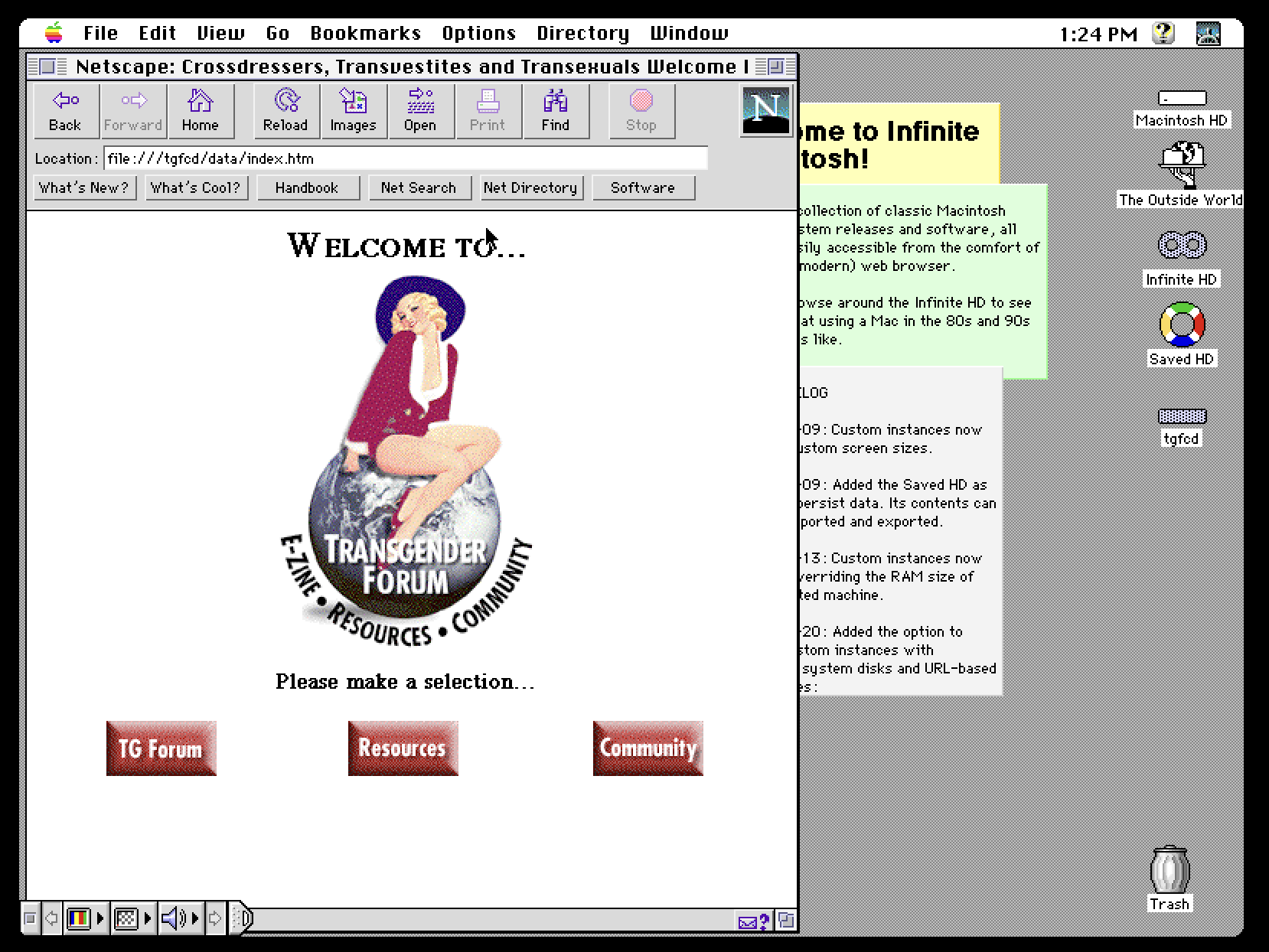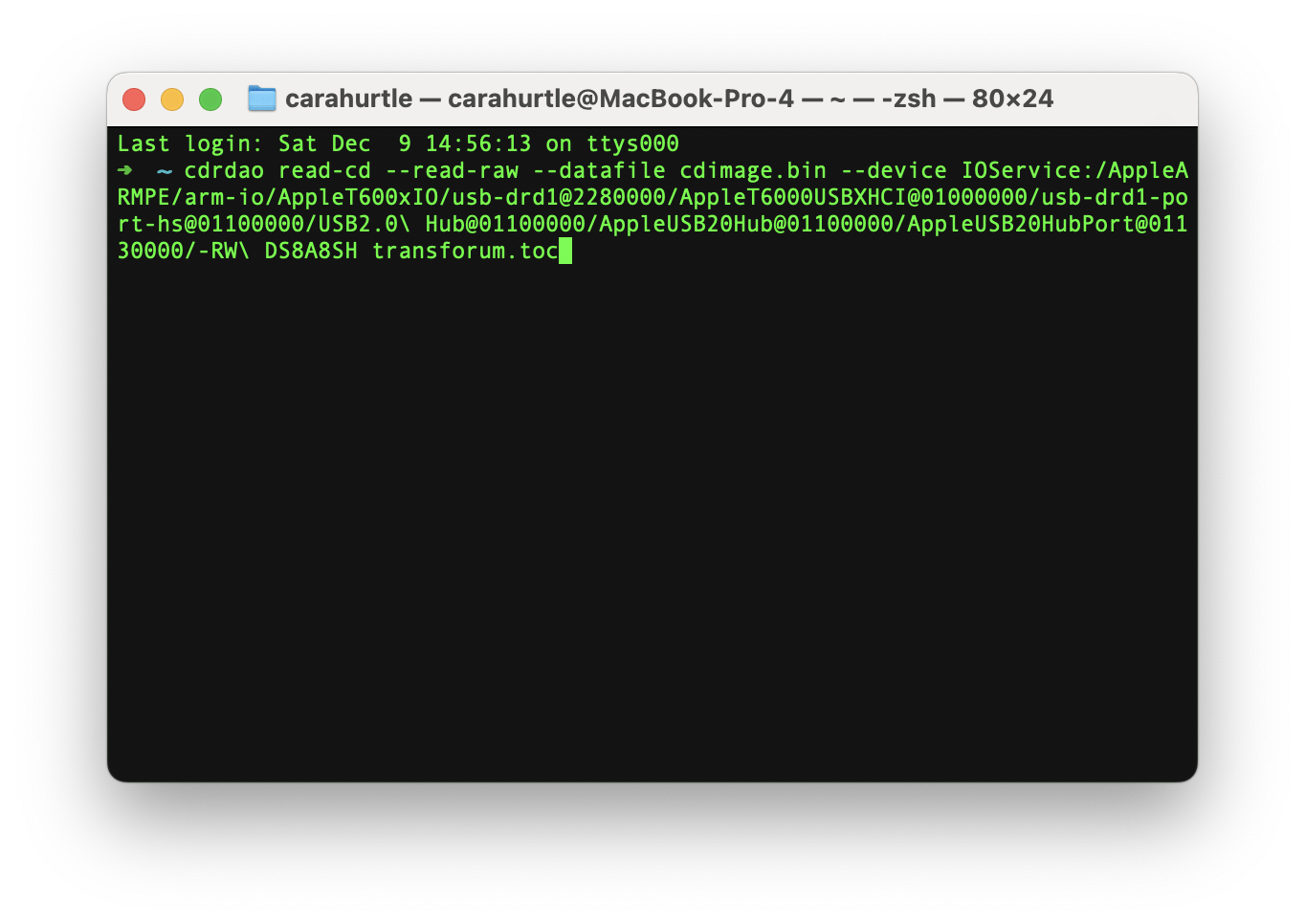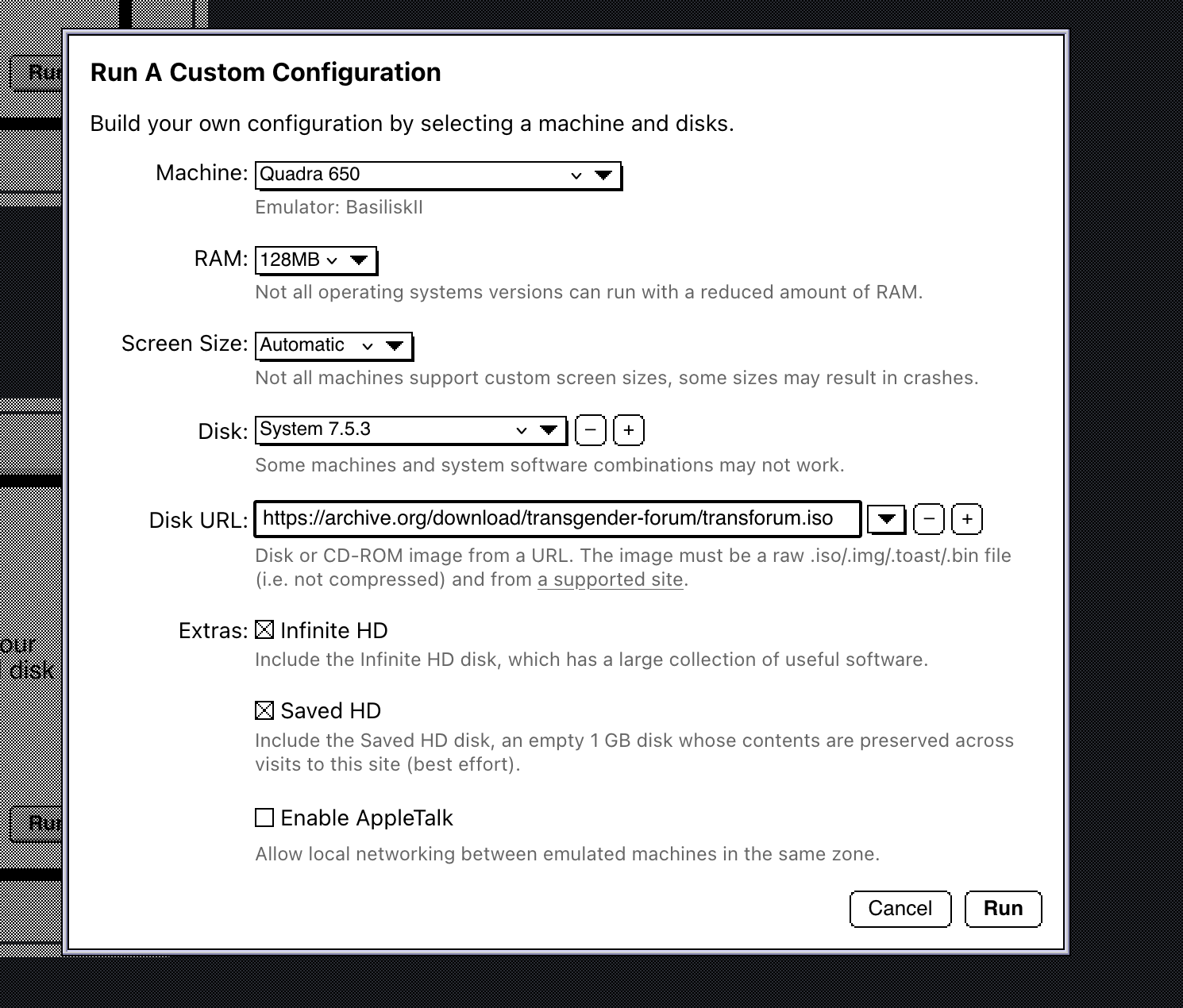This is the first of a new series of posts I’m writing about the various pieces of media I’ve been tasked with preserving at the Gay, Lesbian, Bisexual, and Transgender Historical Society in San Francisco. Since October, I’ve been volunteering my time there as a specialist in digital preservation, and this series will attempt to be a deep dive into the technical details of preserving obsolete hardware, software, and files.
Much has already been written about the Transgender Forum CD-ROM that I archived and posted on the Internet Archive; them. magazine wrote a long piece on the history of the site, its founders, and the place it occupied on the early trans internet. The author of that piece, Samantha Riedel, spoke on NPR about it as well. Various Instagram accounts have shared memes from the CD; it’s absolutely made a splash in the online trans community, and I’ve been delighted to see it.

When Devin Muchmore, a staff archivist at the Historical Society, came in with a shrink-wrapped CD while I was working on the Anything That Moves magazine archives (more on that to come!), I was beyond excited to see what was on it. When I popped it into my computer and fired up a Mac emulator, it was immediately obvious that others would get a kick out of seeing into this window on the mid-90s trans-feminine experience, and that they should do it in the most context-appropriate way possible: a mid-90s Mac running Netscape.
Obviously we can’t all be so blessed as to have a house uncomfortably full of vintage electronics, so I set about trying to figure out how to get this in people’s hands with the minimum amount of effort possible.
Hybrid theory
Let’s talk about CD-ROMs. There’s a standard filesystem for CD-ROMs called ISO 9660. It’s neither the standard Windows filesystem of the time (File Allocation Table, or FAT) nor is it the 90s Mac filesystem (Hierarchical File System, or HFS), but rather an independent system that aimed to be readable by any operating system. However, it had fairly severe limitations: it could only nest files up to 8 folders deep, filenames could only be 8 characters long, and perhaps most importantly, it didn’t support resource forks, an essential part of how early MacOS computers stored data. So, in order to get around these limitations, CD-ROM distributors would create what was called a hybrid disc.
A hybrid disc contains two filesystems on the same CD-ROM: one ISO 9660 filesystem that could be read on PCs, and another HFS filesystem, that would contain data for Macintosh computers. The ISO 9660 filesystem could even point to data on the HFS filesystem, making it so you really only needed to store each file once. The Transgender Forum CD-ROM uses a hybrid filesystem; initially, I created an image from just the HFS partition that my MacBook Pro I was using for archiving could see. Unfortunately, this missed out on the data that existed in the ISO 9660 filesystem; essentially, it was the same data, but I didn’t want to leave this archive incomplete! Because of the hybrid filesystem however, it was difficult to read the whole CD-ROM using the built in command line tools in MacOS. Which brought me to using an extremely helpful tool: cdrdao.
Learning to read
The command-line program cdrdao reads an entire disc at once, including the lead-in, lead-out, and any tracks the CD may contain. This makes it an incredible tool not only for archiving a hybrid CD-ROM, but also so-called Mixed Mode CDs, which are CDs that contain both data and audio tracks. This was fairly commonplace in 90s CD-ROM games, which would store music on separate audio tracks that could be cued up as the game progressed.
cdrdao, then, outputs certain files as it reads a CD-ROM: a table of contents file in plain text that explains where tracks start and end, various .bin files for the data tracks, and .wav files for the audio tracks. Transgender Forum only had a single .toc and .bin file to represent its contents. The pair of table-of-contents and binary .bin file is often called toc/bin; it’s one of a number of formats that represent CD data in this way, the most popular being bin/cue.

Once I had the Transgender Forum CD in bin/toc format out of cdrdao, I renamed the default-output bin file name to transforum.bin, opened up the toc file in a text editor, renamed the binary data file for track one to transforum.bin, then ran a new program, toc2cue, which simply converts the toc file to the more popular cue file. This combination of transforum.bin and transforum.cue is essentially a complete archive of the Transgender Forum CD-ROM. With this, any person could burn their own copy of the CD. However, it still wasn’t in the most common CD-ROM image format: ISO.
The treachery of images
ISO images are representations of only the data track of a CD-ROM. You can’t store a Mixed Mode CD as an ISO, because the audio tracks would be missing. In our case, however, we only have the data track; despite MacOS not being able to properly image it to a single file, it is possible to represent the CD in its entirety without the table of contents. I wanted to make sure that was part of the final archive, largely because it makes the image much easier to work with, and for it to be readable by a variety of emulators.
Thankfully, the program bchunk does exactly what we need for this, and does it easily. All I had to do was run it with the following parameters:
bchunk transforum.bin transforum.cue transforum.iso
…and presto, there’s an ISO.
But What Does It Do?
Preserving data is all well and good but my focus, especially with things like this, is making that data interactive. I doubt this would’ve made nearly the splash it did if it were just an image file sitting on the Internet Archive. Thankfully, the incredible Infinite Mac project run by developer Mihai Parparita does exactly what we need here. Parparita and various open source contributors have set up a piece of software that runs an old Macintosh system completely in the user’s browser, alongside a pre-installed set of period-appropriate software packages, including early Netscape browsers. This is exactly what I needed to show off Transgender Forum in all its 90s glory.
Once the image was posted to the Internet Archive, I created a link to a custom system profile in InfiniteMac that emulated a Quadra 650 (one of the last and fastest non-PowerPC Macintoshes from 1994) running System 7.5.3, and pointed directly to the ISO file I uploaded. This creates a custom link to that system which can then be shared; all anyone would have to do is click a single link, and it would load an era-appropriate Macintosh system, with the CD-ROM inserted and ready to go.

Want to try it? Click here.
This approach ended up working perfectly; plenty of people were able to go through Transgender Forum on their own computers and get a nearly-flawless representation of this 90s treasure.
To this day, this is one of the things I’m most proud of having a hand in creating, and I hope it remains a useful resource for years to come.
Next up: archiving and presenting the production archives of the groundbreaking 90s bisexual interest magazine Anything That Moves, including how to read damaged zip discs and how to get data from a SCSI Jaz drive to a modern computer! Stay tuned!